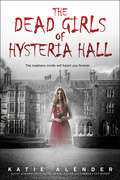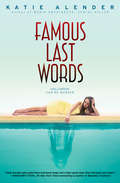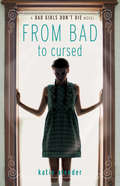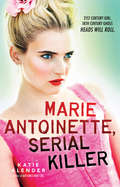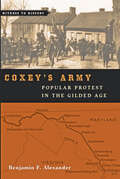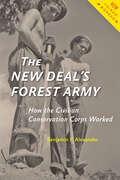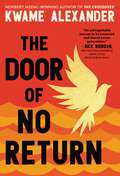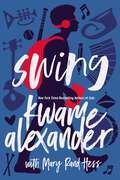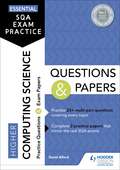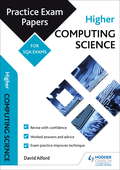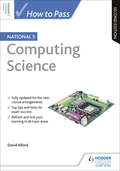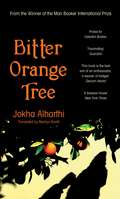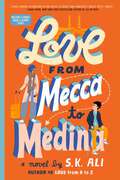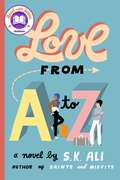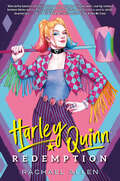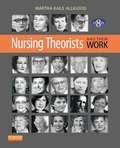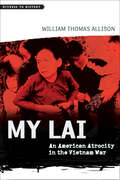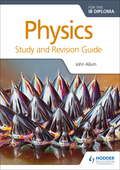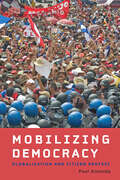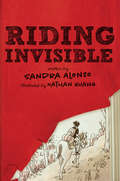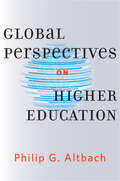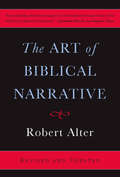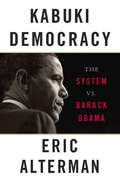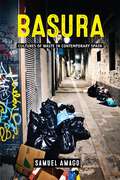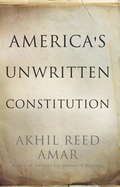- Table View
- List View
The Dead Girls of Hysteria Hall (Point Ser.)
by Katie AlenderIN THIS ASYLUM, YOUR MIND PLAYS TRICK ON YOU ALL THE TIME ...Delia's new house isn't just a house. Long ago, it was the Piven Institute for the Care and Correction of Troubled Females -- an insane asylum nicknamed "Hysteria Hall." However, many of the inmates were not insane, just defiant and strong willed. Kind of like Delia herself.But the house still wants to keep "troubled" girls locked away. So, in the most horrifying way, Delia becomes trapped. And that's when she learns that the house is also haunted.Ghost girls wander the hallways in their old-fashioned nightgowns. A handsome ghost boy named Theo roams the grounds. Delia learns that all the spirits are unsettled and full of dark secrets. The house, too, harbors shocking truths within its walls -- truths that only Delia can uncover, and that may set her free. And she'll need to act quickly -- before the house's power overtakes everything she loves.Katie Alender brings heart-pounding suspense, gorgeous writing, and a feminist twist to this tale of memories and madness.
Famous Last Words
by Katie AlenderHollywood history, mystery, murder, mayhem, and delicious romance collide in this unputdownable thriller from master storyteller Katie Alender.Willa is freaking out. It seems like she's seeing things. Like a dead body in her swimming pool. Frantic messages on her walls. A reflection that is not her own. It's almost as if someone -- or something -- is trying to send her a message.Meanwhile, a killer is stalking Los Angeles -- a killer who reenacts famous movie murder scenes. Could Willa's strange visions have to do with these unsolved murders? Or is she going crazy? And who can she confide in? There's Marnie, her new friend who may not be totally trustworthy. And there's Reed, who's ridiculously handsome and seems to get Willa. There's also Wyatt, who's super smart but unhealthily obsessed with the Hollywood Killer.All Willa knows is, she has to confront the possible-ghost in her house, or she just might lose her mind . . . or her life.Acclaimed author Katie Alender puts an unforgettable twist on this spine-chilling tale of murder, mystery, mayhem -- and the movies.
From Bad to Cursed (Bad Girls Don't Die #2)
by Katie AlenderAlexis is the last girl you'd expect to sell her soul. She already has everything she needs--an adorable boyfriend, the perfect best friend, and a little sister who's finally recovering after being possessed by an evil spirit, then institutionalized. Alexis is thrilled when her sister joins a club; new friends are just what Kasey needs. It's strange, though, to see how fast the girls in The Sunshine Club go from dorky and antisocial to gorgeous and popular.
Marie Antoinette, Serial Killer
by Katie AlenderHeads will roll!Paris, France: a city of fashion, chocolate croissants, and cute boys. Colette Iselin is thrilled be there for the first time, on her spring break class trip.But a series of gruesome murders are taking place around the city, putting everyone on edge. And as she tours the sights, Colette keeps seeing a strange vision: a pale woman in a ball gown and powdered wig, who looks like Marie Antoinette.Colette knows her status-obsessed friends won't believe her, so she seeks out the help of a charming French boy. Together, they discover that the murder victims areall descendants of people who ultimately brought about Marie Antoinette's beheading. The queen's ghost has been awakened, and now she's wreaking her bloodthirsty revenge.And Colette may just be one of those descendants . . . which means she might not make it out of this trip alive.Acclaimed author Katie Alender brings heart-stopping suspense to this story of betrayal, glamour, mystery, history--and one killer queen.
Coxey's Army: Popular Protest in the Gilded Age (Witness to History)
by Benjamin F. AlexanderThe engrossing tale of the first audacious protest march on Washington—a precursor of the Occupy movement.In 1893, after a major British bank failure, a run on U.S. gold reserves, and a late-June stock-market crash, America was in the throes of a serious economic depression. Unemployment rose, foreclosures climbed, and popular unrest mounted. By the following spring, businessman and Populist agitator Jacob S. Coxey was fed up with government inactivity in the face of the crisis. With the help of eccentric showman Carl Browne, he led a group of several hundred unemployed wage earners, small farmers, and crossroads merchants on a march from Massillon, Ohio, to Washington, D.C., to present a "petition in boots" for government-financed jobs building and repairing the nation’s roads. On May 1, the Coxeyites descended on the center of government, where Coxey attempted to deliver a speech on the Capitol steps. The police attacked, a melee ensued, and Coxey and Browne spent a month in jail. Meanwhile, other Coxey-inspired contingents were on their way east from places as far away as San Francisco and Portland. Some of them even hijacked trains along the way. Who was Coxey, and what motivated him—along with the angry marchers who joined his cause? What did other Americans think of the protesters? Was there ever any chance that the protesters’ demands would be met? Where did the agitators fit in with the politics of their day, and how did their actions jibe with the other labor-related protests happening that year? In this concise and gripping narrative, Benjamin F. Alexander contextualizes the march by vividly describing the misery wrought by the Panic of ’93. Alexander brings both Coxey and his fellow leaders to life, along with the reporters and spies who traveled with them and the diverse group of captivated newspaper readers who followed the progress of the marches and train heists.Coxey’s Army explains how the demands of the Coxeyites—far from being the wild schemes of a small group of cranks—fit into a larger history of economic theories that received serious attention long before and long after the Coxey march. Despite running a gauntlet of ridicule, the marchers laid down a rough outline of what, some forty years later, emerged as the New Deal.
The New Deal's Forest Army: How the Civilian Conservation Corps Worked (How Things Worked)
by Benjamin F. AlexanderHow the Civilian Conservation Corps constructed, rejuvenated, and protected American forests and parks at the height of the Great Depression.Propelled by the unprecedented poverty of the Great Depression, President Franklin D. Roosevelt established an array of massive public works programs designed to provide direct relief to America’s poor and unemployed. The New Deal’s most tangible legacy may be the Civilian Conservation Corps’s network of parks, national forests, scenic roadways, and picnic shelters that still mark the country’s landscape. CCC enrollees, most of them unmarried young men, lived in camps run by the Army and worked hard for wages (most of which they had to send home to their families) to preserve America’s natural treasures. In The New Deal’s Forest Army, Benjamin F. Alexander chronicles how the corps came about, the process applicants went through to get in, and what jobs they actually did. He also explains how the camps and the work sites were run, how enrollees spent their leisure time, and how World War II brought the CCC to its end. Connecting the story of the CCC with the Roosevelt administration’s larger initiatives, Alexander describes how FDR’s policies constituted a mixed blessing for African Americans who, even while singled out for harsh treatment, benefited enough from the New Deal to become an increasingly strong part of the electorate behind the Democratic Party. The CCC was the only large-scale employment program whose existence FDR foreshadowed in speeches during the 1932 campaign—and the dearest to his heart throughout the decade that it lasted. Alexander reveals how the work itself left a lasting imprint on the country’s terrain as the enrollees planted trees, fought forest fires, landscaped public parks, restored historic battlegrounds, and constructed dams and terraces to prevent floods. A uniquely detailed exploration of life in the CCC, The New Deal’s Forest Army compellingly demonstrates how one New Deal program changed America and gave birth to both contemporary forestry and the modern environmental movement.
The Door of No Return (The Door of No Return series #1)
by Kwame AlexanderFrom the Newbery Medal and Coretta Scott King Award winning author Kwame Alexander, comes the first book in a searing, breathtaking trilogy that tells the story of a boy, a village, and the epic odyssey of an African family. In his village in Upper Kwanta, 11-year-old Kofi loves his family, playing oware with his grandfather and swimming in the river Offin. He&’s warned though, to never go to the river at night. His brother tells him &”There are things about the water you do not know. &“ Like what? Kofi asks. &“The beasts.&” His brother answers. One fateful night, the unthinkable happens and in a flash, Kofi&’s world turns upside down. Kofi soon ends up in a fight for his life and what happens next will send him on a harrowing journey across land and sea, and away from everything he loves. This spellbinding novel by the author of The Crossover and Booked will take you on an unforgettable adventure that will open your eyes and break your heart. The Door of No Return is an excellent choice for independent reading, sharing in the classroom, book groups, and homeschooling.An instant #1 New York Times Bestseller!
Swing
by Kwame Alexander Mary Rand HessIn this YA novel in verse from bestselling authors Kwame Alexander and Mary Rand Hess (Solo), which Kirkus called “lively, moving, and heartfelt” in a starred review, Noah and Walt just want to leave their geek days behind and find “cool,” but in the process discover a lot about first loves, friendship, and embracing life . . . as well as why Black Lives Matter is so important for all.Best friends Noah and Walt are far from popular, but Walt is convinced junior year is their year, and he has a plan that includes wooing the girls of their dreams and becoming amazing athletes. Never mind he and Noah failed to make their baseball team yet again, and Noah’s crush since third grade, Sam, has him firmly in the friend zone. While Walt focuses on his program of jazz, podcasts, batting cages, and a “Hug Life” mentality, Noah feels stuck in status quo … until he stumbles on a stash of old love letters. Each one contains words Noah’s always wanted to say to Sam, and he begins secretly creating artwork using the lines that speak his heart. But when his art becomes public, Noah has a decision to make: continue his life in the dugout and possibly lose the girl forever, or take a swing and finally speak out.At the same time, American flags are being left around town. While some think it’s a harmless prank and others see it as a form of protest, Noah can’t shake the feeling something bigger is happening to his community. Especially after he witnesses events that hint divides and prejudices run deeper than he realized.As the personal and social tensions increase around them, Noah and Walt must decide what is really important when it comes to love, friendship, sacrifice, and fate.Swing:is written by New York Times bestselling author and Newbery Medal and Coretta Scott King Award-winner Kwame AlexanderFeatures a diverse array of characters and perspectivestackles the biggest social issues of today, including racial prejudice and Black Lives Matteris perfect reading for the classroom or community-wide discussionsis a 2020 YALSA Quick Pick for Reluctant Young Adult Readerscontains original artwork tied to the storyIf you enjoy Swing, check out Solo by Kwame Alexander and Mary Rand Hess.
Essential SQA Exam Practice: Higher Computing Science Questions and Papers
by David AlfordExam board: SQALevel: HigherSubject: Computing ScienceFirst teaching: September 2018First exam: Summer 2019Practice makes permanent. Feel confident and prepared for the SQA Higher Computing Science exam with this two-in-one book, containing practice questions for every topic, plus two full practice papers - all written by an experienced marker.- Choose which topics you want to revise: A simple grid enables you to pick particular areas of the course that you want to answer questions on, with solutions provided at the back of the book- Remember more in your exam: Repeated and extended practice will give you a secure knowledge of the key areas of the course (software design and development; computer systems; database design and development; web design and development) Familiarise yourself with the exam paper: Both practice papers mirror the language and layout of the real SQA papers; complete them in timed, exam-style conditions to increase your confidence before the exams- Find out how to achieve a better grade: Answers to the practice papers have commentaries for each question, with tips on writing successful answers and avoiding common mistakesFully up to date with SQA's requirementsThe questions, mark schemes and guidance in this practice book match the requirements of the revised SQA Higher Computing Science specification for examination from 2019 onwards.
Higher Computing Science: HCOMPPEP
by David AlfordPractise for your SQA exams with three specially-commissioned Hodder Gibson Practice Exam Papers.- Practise with model papers written and checked by experienced markers and examiners- Get extra advice with specially-written study-skills guidance sections- Gain vital extra marks and avoid common mistakes with examiner tips
How to Pass National 5 Computing Science: Second Edition
by David AlfordExam Board: SQALevel: National 5Subject: Computing ScienceFirst Teaching: August 2017First Exam: May 2018Get your best grade with the SQA endorsed guide to National 5 Computing Science.Fully updated to account for the removal of Unit Assessments and the changes to the National 5 exam, this book contains all the advice and support you need to revise successfully. It combines an overview of the course syllabus with advice from a top expert on how to improve exam performance, so you have the best chance of success.- Refresh your knowledge with complete course notes- Prepare for the exam with top tips and hints on revision technique- Get your best grade with advice on how to gain those vital extra marks
Bitter Orange Tree
by Jokha AlharthiZuhur, an Omani student at a British university, is caught between the past and the present. As she attempts to form friendships and assimilate in Britain, she can&’t help but ruminate on the relationships that have been central to her life. Most prominent is her strong emotional bond with Bint Amir, a woman she always thought of as her grandmother, who passed away just after Zuhur left the Arabian Peninsula. As the historical narrative of Bint Amir&’s challenged circumstances unfurls in captivating fragments, so too does Zuhur&’s isolated and unfulfilled present, one narrative segueing into another as time slips, and dreams mingle with memories.The eagerly awaited new novel by the winner of the Man Booker International Prize, Bitter Orange Tree is a profound exploration of social status, wealth, desire, and female agency. It presents a mosaic portrait of one young woman&’s attempt to understand the roots she has grown from, and to envisage an adulthood in which her own power and happiness might find the freedom necessary to bear fruit and flourish.
Love from Mecca to Medina
by S. K. AliOn the trip of a lifetime, Adam and Zayneb must find their way back to each other in this surprising and romantic sequel to the &“bighearted, wildly charming&” (Becky Albertalli, New York Times bestselling author) Love from A to Z that&’s a &“contemplative exploration of faith, love, and the human condition&” (Kirkus Reviews, starred review).Adam and Zayneb. Perfectly matched. Painfully apart. Adam is in Doha, Qatar, making a map of the Hijra, a historic migration from Mecca to Medina, and worried about where his next paycheck will come from. Zayneb is in Chicago, where school and extracurricular stresses are piling on top of a terrible frenemy situation, making her miserable. Then a marvel occurs: Adam and Zayneb get the chance to spend Thanksgiving week on the Umrah, a pilgrimage to Mecca and Medina, in Saudi Arabia. Adam is thrilled; it&’s the reboot he needs and an opportunity to pray for a hijra in real life: to migrate to Zayneb in Chicago. Zayneb balks at the trip at first, having envisioned another kind of vacation, but then decides a spiritual reset is calling her name too. And they can&’t wait to see each other—surely, this is just what they both need. But the trip is nothing like what they expect, from the appearance of Adam&’s former love interest in their traveling group to the anxiety gripping Zayneb when she&’s supposed to be &“spiritual.&” As one wedge after another drives them apart while they make their way through rites in the holy city, Adam and Zayneb start to wonder: was their meeting just an oddity after all? Or can their love transcend everything else like the greatest marvels of the world?
Love from A to Z
by S. K. Ali&“The bighearted, wildly charming, painfully real love story I&’ve been waiting for.&” —Becky Albertalli, New York Times bestselling author of Simon vs. the Homo Sapiens Agenda &“Heartfelt and powerful.&” —Kirkus Reviews (starred review) From William C. Morris Award Finalist S.K. Ali comes an unforgettable romance that is The Sun Is Also a Star meets Anna and the French Kiss, following two Muslim teens who meet during a spring break trip.A marvel: something you find amazing. Even ordinary-amazing. Like potatoes—because they make French fries happen. Like the perfect fries Adam and his mom used to make together. An oddity: whatever gives you pause. Like the fact that there are hateful people in the world. Like Zayneb&’s teacher, who won&’t stop reminding the class how &“bad&” Muslims are. But Zayneb, the only Muslim in class, isn&’t bad. She&’s angry. When she gets suspended for confronting her teacher, and he begins investigating her activist friends, Zayneb heads to her aunt&’s house in Doha, Qatar, for an early start to spring break. Fueled by the guilt of getting her friends in trouble, she resolves to try out a newer, &“nicer&” version of herself in a place where no one knows her. Then her path crosses with Adam&’s. Since he got diagnosed with multiple sclerosis in November, Adam&’s stopped going to classes, intent, instead, on perfecting the making of things. Intent on keeping the memory of his mom alive for his little sister. Adam&’s also intent on keeping his diagnosis a secret from his grieving father. Alone, Adam and Zayneb are playing roles for others, keeping their real thoughts locked away in their journals. Until a marvel and an oddity occurs… Marvel: Adam and Zayneb meeting. Oddity: Adam and Zayneb meeting.
Harley Quinn: Redemption (DC Icons Series #3)
by Rachael AllenWhen girls in Gotham City go missing, Harley Quinn is determined to track down their kidnapper. But the only way to outsmart a villain is to engage in a little villainy herself. Don't miss the adrenaline-racing conclusion to the Harley Quinn trilogy.In Gotham City even the heroes are wicked.Harley Quinn and Poison Ivy can't wait to cross off the final items on their summer bucket list. They still need to:Go to PrideGet mani/pedisFigure out how they can kiss without Ivy's toxic lips killing Harley. (Every relationship has its challenges!)But their to-do list gets more dangerous when young girls vanish from the streets of Gotham City. The only clues left behind are the dolls on Harley's doorstep from a mysterious sender known as the Dollmaker. The message is clear: come find me…if you dare.Award-winning author Rachael Allen delivers the fast-paced and fiercely feminist conclusion to the Harley Quinn trilogy.&“Allen&’s Harley is a fierce, righteous, brilliant, and preternaturally brace ball of chaos. I loved and feared every single minute with her.&” –Dahlia Adler, author of Cool for the Summer
Nursing Theorists and Their Work (8th Edition)
by Martha Raile AlligoodThe most comprehensive of its kind, Nursing Theorists and Their Work, 8th Edition provides an in-depth look at 39 theorists of historical, international, and significant importance. Each chapter features a clear, consistent presentation of a key nursing philosophy or theory. Case studies, critical thinking activities, and in-depth objective critiques of nursing theories help bridge the gap between theory and application. Critical Thinking Activities at the end of each theorist chapter help you to process the theory presented and apply it to personal and hypothetical practice situations. A case study at the end of each theorist chapter puts the theory into a larger perspective, demonstrating how it can be applied to practice. A Brief Summary in each theorist chapter helps you review for tests and confirm your comprehension. A Major Concepts & Definitions box included in each theorist chapter outlines the theory's most significant ideas and clarifies content-specific vocabulary. Each theorist chapter is written by a scholar specializing in that particular theorist's work, often having worked closely with the theorists, to provide the most accurate and complete information possible. Beginning chapters provide a strong foundation on the history and philosophy of science, logical reasoning, and the theory development process. Diagrams for theories help you visualize and better understand inherently abstract concepts. Pictures of theorists, as well as a listing of contact information for each individual, enables you to contact the source of information directly. Theorist chapters have been reviewed and edited by the theorist, validating the accounts set forth in the text for currency and accuracy. An extensive bibliography at the conclusion of each theorist chapter outlines numerous primary and secondary sources of information, ideal for both undergraduate and graduate research projects.
My Lai: An American Atrocity in the Vietnam War (Witness to History)
by William Thomas AllisonAllison tells the story of a terrible moment in American history and explores how to deal with the aftermath.On March 16, 1968, American soldiers killed as many as five hundred Vietnamese men, women, and children in a village near the South China Sea. In My Lai William Thomas Allison explores and evaluates the significance of this horrific event. How could such a thing have happened? Who (or what) should be held accountable? How do we remember this atrocity and try to apply its lessons, if any? My Lai has fixed the attention of Americans of various political stripes for more than forty years. The breadth of writing on the massacre, from news reports to scholarly accounts, highlights the difficulty of establishing fact and motive in an incident during which confusion, prejudice, and self-preservation overwhelmed the troops. Son of a Marine veteran of the Vietnam War—and aware that the generation who lived through the incident is aging—Allison seeks to ensure that our collective memory of this shameful episode does not fade.Well written and accessible, Allison’s book provides a clear narrative of this historic moment and offers suggestions for how to come to terms with its aftermath.
Physics for the IB Diploma Study and Revision Guide
by John AllumStretch your students to achieve their best grade with these year round course companions; providing clear and concise explanations of all syllabus requirements and topics, and practice questions to support and strengthen learning. - Consolidate revision and support learning with a range of exam practice questions and concise and accessible revision notes- Practise exam technique with tips and trusted guidance from examiners on how to tackle questions- Focus revision with key terms and definitions listed for each topic/sub topic
Mobilizing Democracy: Globalization and Citizen Protest (Themes in Global Social Change)
by Paul AlmeidaWhat are the conditions and factors that drive people to protest against government economic policies in the developing world?Distinguished Scholarship Award of the Pacific Sociological Association (2015)Paul Almeida’s comparative study of the largest social movement campaigns that existed between 1980 and 2013 in every Central American country (Costa Rica, El Salvador, Guatemala, Honduras, Nicaragua, and Panama) provides a granular examination of the forces that spark mass mobilizations against state economic policy, whether those factors are electricity rate hikes or water and health care privatization. Many scholars have explained connections between global economic changes and local economic conditions, but most of the research has remained at the macro level. Mobilizing Democracy contributes to our knowledge about the protest groups "on the ground" and what makes some localities successful at mobilizing and others less successful. His work enhances our understanding of what ingredients contribute to effective protest movements as well as how multiple protagonists—labor unions, students, teachers, indigenous groups, nongovernmental organizations, women’s groups, environmental organizations, and oppositional political parties—coalesce to make protest more likely to win major concessions.Based on extensive field research, archival data of thousands of protest events, and interviews with dozens of Central American activists, Mobilizing Democracy brings the international consequences of privatization, trade liberalization, and welfare-state downsizing in the global South into focus and shows how persistent activism and network building are reactivated in these social movements. Almeida enables our comprehension of global and local politics and policy by answering the question, "If all politics is local, then how do the politics of globalization manifest themselves?" Detailed graphs and maps provide a synthesis of the quantitative and qualitative data in this important study. Written in clear, accessible prose, this book will be invaluable for students and scholars in the fields of political science, social movements, anthropology, Latin American studies, and labor studies.
Riding Invisible
by Sandra AlonzoFifteen-year-old Yancy runs away from home on the night his brother viciously attacks his horse, Shy. With just a backpack, a flashlight, his horse, and a journal, Yancy takes to the California desert on a journey of self-discovery. There he will learn the hardships of being homeless, experience his first kiss, and meet a Mexican laborer, Tavo, who has a thing or two to teach him about life and love. Debut novelist Sandra Alonzo creates an honest portrait of a family dealing with mental disease.
Global Perspectives on Higher Education: Insights From Key Global Publications (Global Perspectives On Higher Education Ser. #36)
by Philip G. AltbachThe single best book on higher education as a global phenomenon.Over the past half-century, globalization has had a profound impact on postsecondary education. The twin forces of mass higher education and the global knowledge economy have driven an unprecedented transformation. These fundamental changes have pulled in opposite directions: one pushes for wider access and accompanying challenges of quality, the other toward exclusive, "world class" research-oriented universities. In Global Perspectives on Higher Education, renowned higher education scholar Philip G. Altbach offers a wide-ranging perspective on the implications of these key forces and explores how they influence academe everywhere. Altbach begins with a discussion of the global trends that increasingly affect higher education, including the implications of mass enrollments, the logic of mass higher education systems around the world, and specific challenges facing Brazil, Russia, India, and China. He considers the numerous implications of globalization, including the worldwide use of the English language, university cross-border initiatives, the role of research universities in developing countries, the impact of the West on Asian universities, and the expansion of private higher education.Provocative and wide-ranging, Global Perspectives on Higher Education considers how the international exchange of ideas, students, and scholars has fundamentally altered higher education.
The Art of Biblical Narrative
by Robert AlterSince it was first published nearly three decades ago,The Art of Biblical Narrativehas radically expanded the horizons of biblical scholarship by recasting the Bible as a work of literary art deserving studied criticism. Renowned critic and translator Robert Alter presents the Hebrew Bible as a cohesive literary work, one whose many authors used innovative devices such as parallelism, contrastive dialogue, and narrative tempo to tell one of the most revolutionary stories of human history: the revelation of a single god.
Kabuki Democracy: The System vs. Barack Obama
by Eric AltermanIn this “agenda-setting” polemic, journalist and historian Eric Alterman explains what is really happening with the Obama presidency. While Obama’s many compromises have disappointed liberals, Alterman argues that these concessions are largely due to a political system that is rigged against progressive change. These structural impediments to democracy have made the keeping of Obama’s campaign promises all but impossible. Brilliantly blending incisive political analysis with a clear agenda for change,Kabuki Democracycuts through the clichés of conservative propaganda and lazy mainstream media analysis to demonstrate that genuine “change” will come to America only when people care enough to challenge the system.
Basura: Cultures of Waste in Contemporary Spain (Under the Sign of Nature)
by Samuel AmagoWhat makes trash trash? How do we decide what to throw away? Driven by these questions and others, Samuel Amago takes us through the streets and alleys of Spain, sorting through recycling bins, libraries, social media, bookstores, and message boards in search of things that have been forgotten, jettisoned, forsaken. Ranging in topic from the transformation of urban space during the transition to democracy to a twenty-first-century sanitation strike that paralyzed Madrid for weeks, from the films of Pedro Almodóvar to graphic novels about Spain’s housing crisis, Basura presents an alternative story of contemporary Spanish culture through the lens of wasted things.Not merely an environmental problem, the proliferation of trash is an indicator of the social, political, and economic processes that undergird late, neoliberal capitalism. In chapters on cinema, photography, archaeology, drawing, comics, literature, ecology, and urban design, Amago places waste objects into dialogue with the cultural practices and structures of power that have produced them. Drawing from archaeological, ecocritical, and new materialist approaches, Amago argues that discards possess agency and generate an array of effects. Just as trash never fully disappears but returns to haunt its creators, so history never vanishes despite being buried or ignored by official narratives. Basura considers the efforts of artists, writers, and designers for whom waste is a means to withstand cultural erasure.
America's Unwritten Constitution: The Precedents and Principles We Live By
by Akhil Reed AmarDespite its venerated place atop American law and politics, our written Constitution does not enumerate all of the rules and rights, principles and procedures that actually govern modern America. The document makes no explicit mention of cherished concepts like the separation of powers and the rule of law. On some issues, the plain meaning of the text misleads. For example, the text seems to say that the vice president presides over his own impeachment trial-but surely this cannot beright. As esteemed legal scholar Akhil Reed Amar explains inAmerica’s Unwritten Constitution, the solution to many constitutional puzzles lies not solely within the written document, but beyond it-in the vast trove of values, precedents, and practices that complement and complete the terse text. In this sequel toAmerica’s Constitution: A Biography, Amar takes readers on a tour of our nation’sunwrittenConstitution, showing how America’s foundational document cannot be understood in textual isolation. Proper constitutional interpretation depends on a variety of factors, such as the precedents set by early presidents and Congresses; common practices of modern American citizens; venerable judicial decisions; and particularly privileged sources of inspiration and guidance, including theFederalistpapers, William Blackstone’sCommentaries on the Laws of England, the Northwest Ordinance of 1787, Lincoln’s Gettysburg Address, and Martin Luther King, Jr. ’s "I Have a Dream” speech. These diverse supplements are indispensible instruments for making sense of the written Constitution. When used correctly, these extra-textual aids support and enrich the written document without supplanting it. An authoritative work by one of America’s preeminent legal scholars,America’s Unwritten Constitutionpresents a bold new vision of the American constitutional system, showing how the complementary relationship between the Constitution’s written and unwritten components is one of America’s greatest and most enduring strengths.
